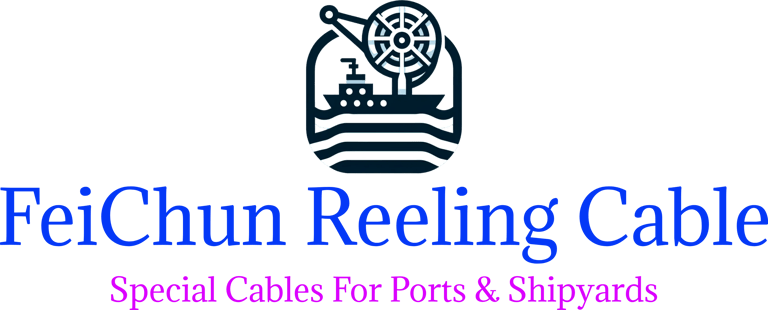Type 2TC-RH Reeling Rubber Cable: Engineered for Horizontal Reel Winding Excellence
Discover the Type 2TC-RH Reeling Rubber Cable—engineered for horizontal reel winding applications. Featuring tin-coated copper conductors, EP rubber insulation, and a polychloroprene sheath, this cable offers exceptional flexibility, durability, and compliance with JIS C 3327 standards. Ideal for dynamic industrial environments requiring reliable performance.
Type 2TC-RH Reeling Rubber Cable: Engineered for Horizontal Reel Winding Excellence
1. Introduction: Empoweting Dynamic Industrial Applications
In the demanding world of dynamic industrial operations, where machinery is in constant motion and reliability is paramount, the selection of appropriate cabling solutions becomes a critical decision point for engineers and system designers. Among the specialized cables engineered for such challenging environments, the Type 2TC-RH reeling rubber cable stands out as a purpose-built solution specifically designed for horizontal reel winding applications.
This specialized cable represents the culmination of advanced materials science and engineering principles, meticulously crafted to withstand the repetitive stress of continuous winding and unwinding operations. Compliant with the rigorous JIS C 3327 standard, the Type 2TC-RH cable delivers exceptional performance under demanding conditions, providing the reliability that modern industrial applications require.
What sets this cable apart is its deliberate engineering to address the unique challenges posed by horizontal reel systems. Unlike static installations where cables remain largely undisturbed, horizontal reel applications subject cables to continuous mechanical stress, requiring solutions that can maintain electrical integrity while withstanding thousands of flexing cycles.
2. Compliance and Standards
The Type 2TC-RH cable's development and manufacturing processes are governed by the JIS C 3327 standard, a comprehensive specification established by the Japanese Industrial Standards Committee. This standard specifically addresses the requirements for reeling cables used in dynamic applications, setting forth stringent criteria for electrical performance, mechanical durability, and environmental resistance.
JIS C 3327 outlines detailed requirements for several critical aspects:
Conductor construction and minimum flexibility
Insulation material properties and thickness
Sheath durability and resistance to environmental factors
Minimum bending radius capabilities
Electrical characteristics under dynamic conditions
Flame retardance and safety parameters
By adhering to these exacting standards, the Type 2TC-RH cable ensures consistent performance and reliability across various industrial applications. This compliance provides system designers and engineers with confidence that the cable will perform as expected even under the most demanding conditions.
Moreover, this adherence to internationally recognized standards facilitates compatibility with equipment from various manufacturers, simplifying integration into existing systems and ensuring consistent performance across different operational environments.
3. Structural Composition and Materials
The exceptional performance of the Type 2TC-RH cable stems from its carefully engineered structural composition, which combines specialized materials selected for their specific properties:
Conductor
At the core of the Type 2TC-RH cable lies a tin-coated annealed copper strand wire conductor. This specialized conductor offers several advantages:
The annealing process creates a highly flexible copper core that can withstand repeated flexing without fatigue failure
The tin coating provides superior corrosion resistance, which is crucial in industrial environments where moisture and chemicals may be present
The stranded construction enhances flexibility while maintaining excellent electrical conductivity
The fine-wire stranding enables a smaller bending radius without compromising electrical performance
Insulation
Surrounding each conductor is a layer of ethylene propylene rubber (EP rubber) insulation. This advanced elastomer provides exceptional electrical and thermal properties:
Outstanding resistance to electrical tracking and breakdown
Excellent heat resistance, allowing for operation at temperatures up to 90°C
Remarkable flexibility across a wide temperature range, from -40°C to +90°C
Superior resistance to water absorption, preventing degradation in humid environments
Excellent aging characteristics, ensuring long-term performance stability
Sheath
The outer sheath consists of specially formulated polychloroprene rubber, commonly known as neoprene. This rugged elastomer provides comprehensive protection against external factors:
Exceptional resistance to abrasion and mechanical damage
Superior oil and chemical resistance, preventing degradation in industrial environments
Excellent weather and ozone resistance for outdoor applications
Inherent flame-retardant properties, enhancing safety in critical installations
Flexibility retention at low temperatures, ensuring reliable operation in cold environments
Reinforcement Layer
Perhaps the most distinctive feature of the Type 2TC-RH cable is its specialized mid-sheath reinforcement layer. This critical component is specifically engineered to:
Prevent twisting during winding and unwinding operations
Distribute mechanical stress evenly throughout the cable structure
Enhance tensile strength without compromising flexibility
Protect inner conductors from the compressive forces experienced during reeling
Extend service life by reducing internal friction between cable components
This thoughtfully designed layer structure creates a cable that delivers exceptional mechanical stability while maintaining the flexibility required for horizontal reel winding applications.
4. Wire Core Identification
Efficient installation and maintenance depend on accurate core identification. The Type 2TC-RH cable employs a comprehensive color-coding system that facilitates quick and accurate identification:
2-core configuration: Black, White
3-core configuration: Black, White, Red
4-core configuration: Black, White, Red, Green
5-core or higher configurations: Black, White, Red, Green, followed by additional cores marked using the tracer method
This standardized color-coding system allows technicians to identify individual conductors quickly and accurately during installation, maintenance, and troubleshooting operations. The clear visual differentiation between cores minimizes the risk of incorrect connections and potential system failures.
For configurations with more than four cores, the tracer method involves adding distinctive stripes or other markings to the basic color scheme, allowing for unambiguous identification even in complex multi-conductor installations.
5. Key Features and Advantages
The Type 2TC-RH cable offers numerous features that make it particularly well-suited for horizontal reel winding applications:
Specialized Design for Horizontal Reeling
Unlike general-purpose cables, the Type 2TC-RH is specifically engineered for the unique stresses of horizontal reel applications. The cable's construction provides:
Optimized balance between flexibility and tensile strength
Resistance to torsional forces that cause twisting
Enhanced performance under repetitive flexing cycles
Consistent electrical characteristics throughout its service life
Mechanical Stability
The cable's reinforced construction provides exceptional stability during operation:
The specialized mid-sheath reinforcement layer prevents twisting and kinking
Enhanced resistance to abrasion from contact with reel surfaces
Superior tensile strength to withstand pulling forces
Ability to maintain shape integrity even after thousands of reeling cycles
Environmental Resistance
Modern industrial environments expose cables to numerous challenging conditions, which the Type 2TC-RH is designed to withstand:
Oil resistance: Prevents degradation when exposed to industrial oils and lubricants
Chemical resistance: Maintains integrity when exposed to common industrial chemicals
UV resistance: Ensures longevity in outdoor applications with direct sunlight exposure
Weather resistance: Performs reliably across various weather conditions
Temperature stability: Maintains flexibility and electrical properties across a wide temperature range
Safety Features
Safety considerations are paramount in industrial applications, and the Type 2TC-RH incorporates several important safety features:
Flame-retardant construction that inhibits fire propagation
Low smoke emission during combustion, enhancing visibility during emergencies
Resistance to electrical tracking and breakdown
Robust insulation that prevents short circuits even under mechanical stress
6. Typical Applications
The unique characteristics of the Type 2TC-RH cable make it ideal for numerous industrial applications where reliability under dynamic conditions is essential:
Horizontal Reel Winding Systems
The primary application for which this cable was designed, including:
Cable reels on mobile equipment
Festoon systems in manufacturing facilities
Power supply systems for moving machinery
Automated material handling equipment
Material Handling Equipment
The cable excels in various material handling applications:
Overhead cranes and hoists
Conveyor systems with mobile components
Stacker and reclaimer systems
Automated storage and retrieval systems (AS/RS)
Mining and Construction Equipment
Rugged environments with constant movement benefit from this cable's durability:
Draglines and excavators
Mobile crushing and screening equipment
Underground mining machinery
Construction cranes and lifts
Other Dynamic Applications
The cable's versatility extends to numerous other uses:
Automated manufacturing cells
Robotic systems with extended reach requirements
Port equipment including ship-to-shore cranes
Entertainment industry applications such as stage lighting and sound equipment
In each of these applications, the Type 2TC-RH cable provides reliable power and signal transmission while withstanding the mechanical stresses inherent in dynamic operations.
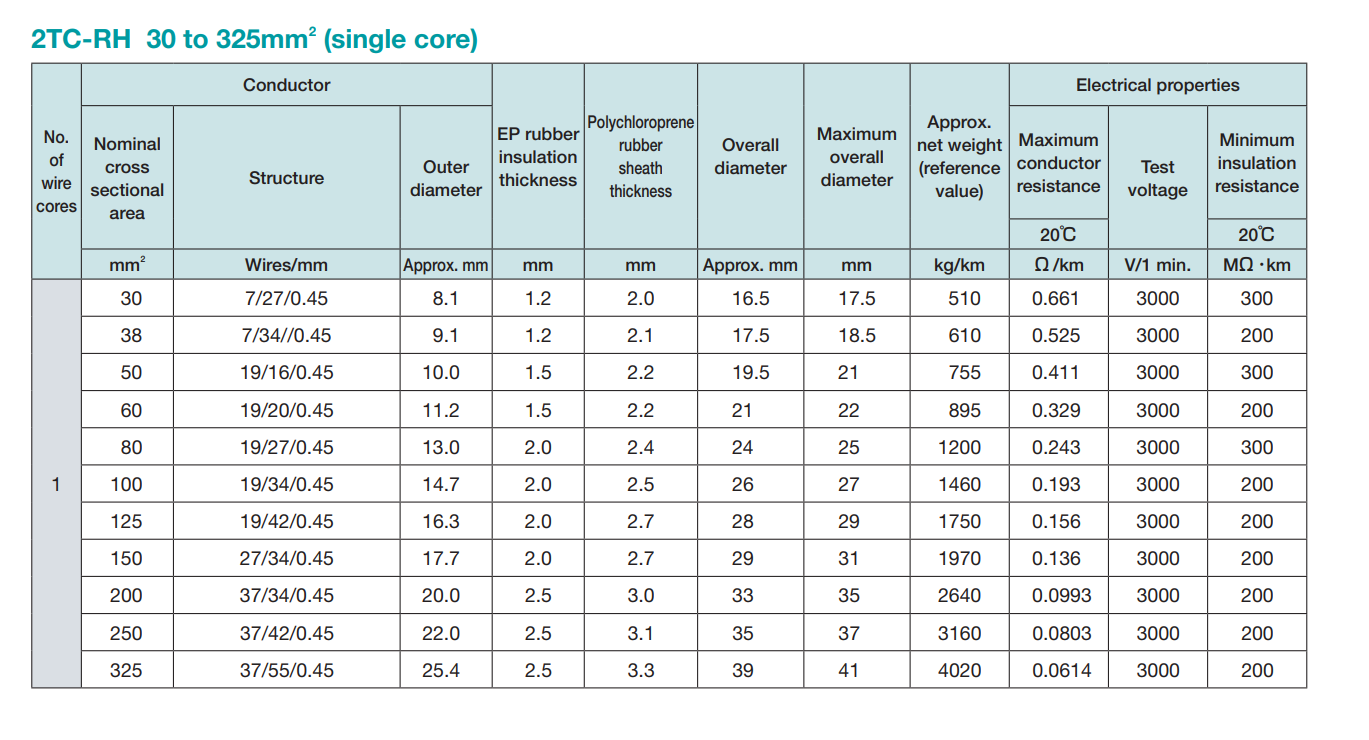

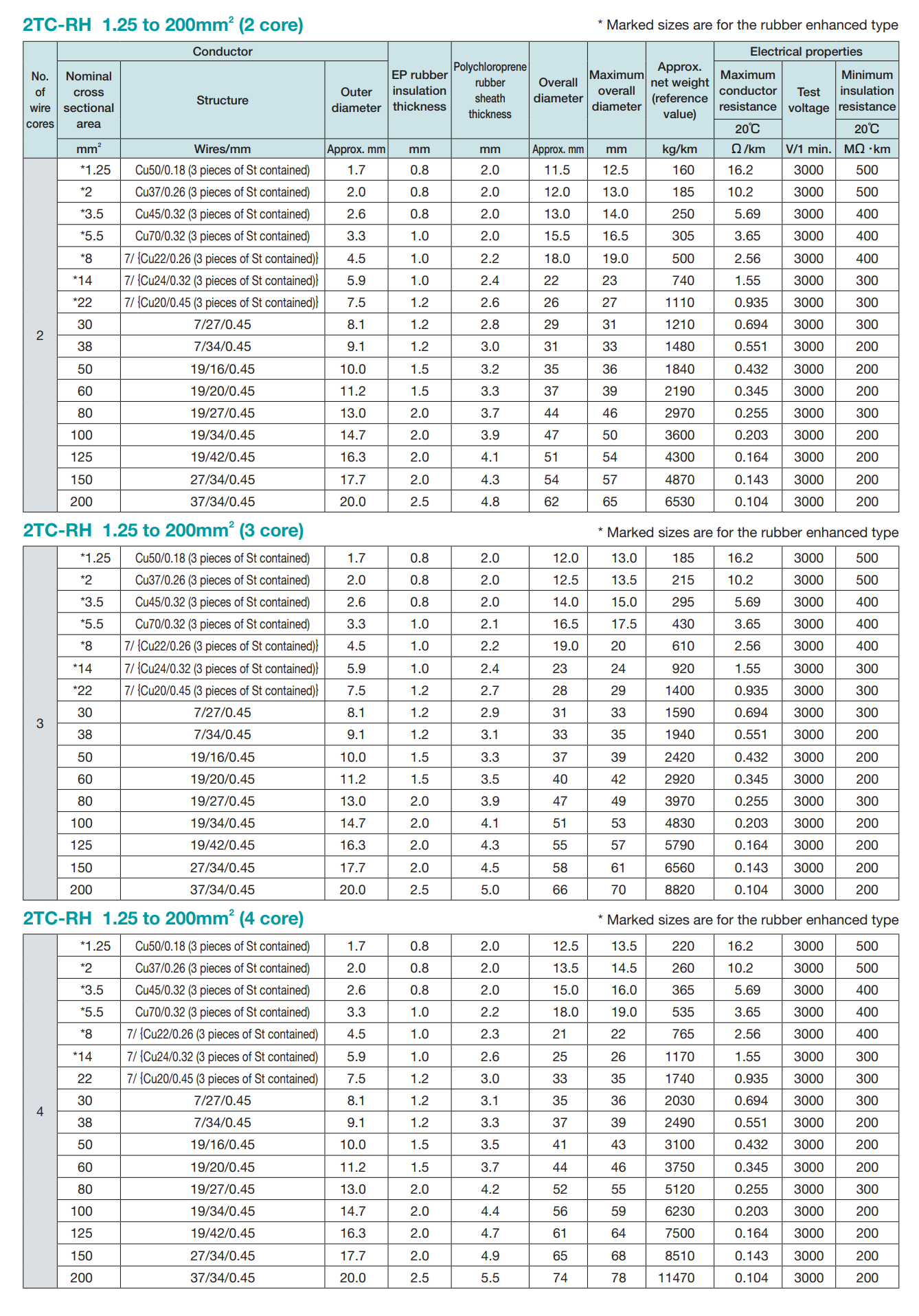

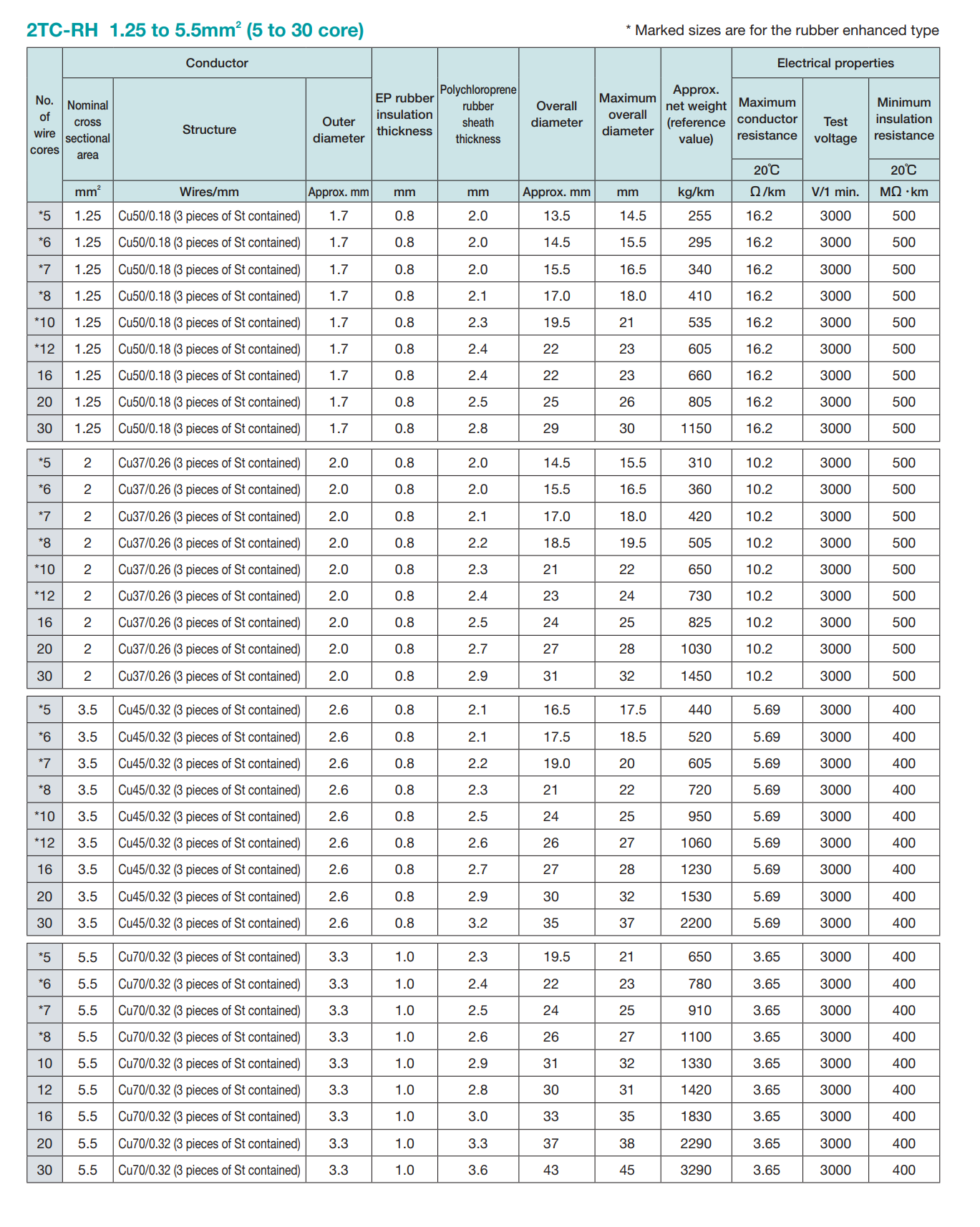

7. Installation Best Practices
Proper installation is crucial for realizing the full performance potential and service life of the Type 2TC-RH cable. Following these best practices will ensure optimal results:
Bending Radius Considerations
Maintaining appropriate bending radius is critical for preventing damage and ensuring longevity:
The minimum bending radius during installation should be at least 8 times the overall cable diameter
The minimum bending radius during operation should be at least 6 times the overall cable diameter
For reeling applications, ensure the reel drum diameter complies with the minimum dynamic bending radius
Avoid sharp bends, particularly at cable entry points to equipment
Proper Securing Techniques
Appropriate securing methods prevent undue stress on the cable structure:
Use properly sized cable clamps that distribute pressure evenly
Employ strain relief devices at termination points
Ensure adequate slack in the cable to prevent tensile stress during operation
When securing multiple cables, avoid over-tightening which can deform the cable cross-section
Termination Methods
Proper termination maintains electrical integrity and mechanical strength:
Use compression-type connectors specifically designed for flexible cables
Ensure complete sealing of termination points to prevent moisture ingress
Implement appropriate strain relief at termination points
Verify proper electrical continuity and insulation resistance after termination
Environmental Considerations
Installation should account for the specific environmental conditions:
Provide additional protection in areas with high abrasion risk
Consider thermal expansion and contraction in environments with wide temperature variations
Implement appropriate moisture protection in wet or humid environments
Ensure adequate ventilation in high-temperature applications
8. Maintenance and Inspection
Regular maintenance and inspection are essential for maximizing the service life of Type 2TC-RH cables:
Routine Inspection Procedures
Implementing scheduled inspections helps identify potential issues before they lead to failure:
Visual inspection for cuts, abrasions, or deformation of the outer sheath
Examination of termination points for signs of stress or loosening
Assessment of cable movement patterns during operation to identify potential stress points
Measurement of insulation resistance to detect degradation before failure occurs
Maintenance Schedule
A comprehensive maintenance schedule should include:
Monthly visual inspection of accessible cable sections
Quarterly detailed inspection of the entire cable length
Semi-annual electrical testing including insulation resistance and continuity
Annual thermographic inspection to identify hot spots indicating potential issues
Troubleshooting Common Issues
Understanding typical failure modes facilitates prompt identification and resolution:
Sheath abrasion: Often occurs at contact points with the reel or guide systems
Conductor fatigue: May develop at points of repeated flexing
Insulation cracking: Can result from exposure to extreme temperatures or chemicals
Core-to-core shorts: May develop due to insulation degradation or mechanical damage
Early identification of these issues allows for timely intervention, preventing catastrophic failure and unplanned downtime.
9. Environmental Considerations
The Type 2TC-RH cable's performance is inherently linked to the environment in which it operates:
Environmental Resistance Properties
The cable's construction provides resistance to numerous environmental factors:
Temperature extremes: Maintains performance from -40°C to +90°C
UV radiation: Resistant to degradation from sunlight exposure
Moisture: Prevents water ingress and maintains electrical integrity in wet conditions
Chemicals: Resists degradation from exposure to common industrial chemicals
Mechanical factors: Withstands abrasion, impact, and vibration
Impact of Environmental Factors on Performance
Various environmental conditions can affect cable performance:
High temperatures accelerate aging of insulation and sheath materials
Low temperatures can reduce flexibility, requiring larger bending radius
Oil and chemical exposure may cause swelling of elastomeric components
Abrasive environments increase mechanical wear on the outer sheath
UV exposure can eventually lead to surface cracking in outdoor installations
Understanding these interactions allows for appropriate installation planning and maintenance scheduling.
Sustainability Aspects
Environmental responsibility extends to the entire cable lifecycle:
The cable's long service life reduces the frequency of replacement and associated waste
Materials are selected for their durability, reducing resource consumption
End-of-life recycling can recover valuable copper from conductors
Proper disposal methods minimize environmental impact when replacement is necessary
10. Conclusion: Investing in Reliability and Performance
The Type 2TC-RH reeling rubber cable represents a specialized solution for the unique challenges posed by horizontal reel winding applications. Its purpose-built construction combines advanced materials with thoughtful engineering to deliver exceptional performance under demanding conditions.
By incorporating tin-coated annealed copper conductors, ethylene propylene rubber insulation, and a polychloroprene rubber sheath with specialized reinforcement, this cable provides the perfect balance of electrical performance, mechanical durability, and environmental resistance required in dynamic industrial settings.
The decision to specify Type 2TC-RH cable for horizontal reel applications is ultimately an investment in operational reliability and system longevity. While initial costs may exceed those of general-purpose cables, the extended service life, reduced maintenance requirements, and prevention of costly downtime deliver significant long-term value.
For applications where continuous motion, mechanical stress, and harsh environmental conditions converge, the Type 2TC-RH cable stands as the optimal solution, providing the performance and reliability that modern industrial operations demand.
When selecting cables for your specific horizontal reeling application, consulting with experienced professionals can help ensure that all operational requirements are met. With its specialized construction and adherence to rigorous standards, the Type 2TC-RH cable represents an ideal choice for engineers and system designers seeking reliable performance in demanding dynamic applications.


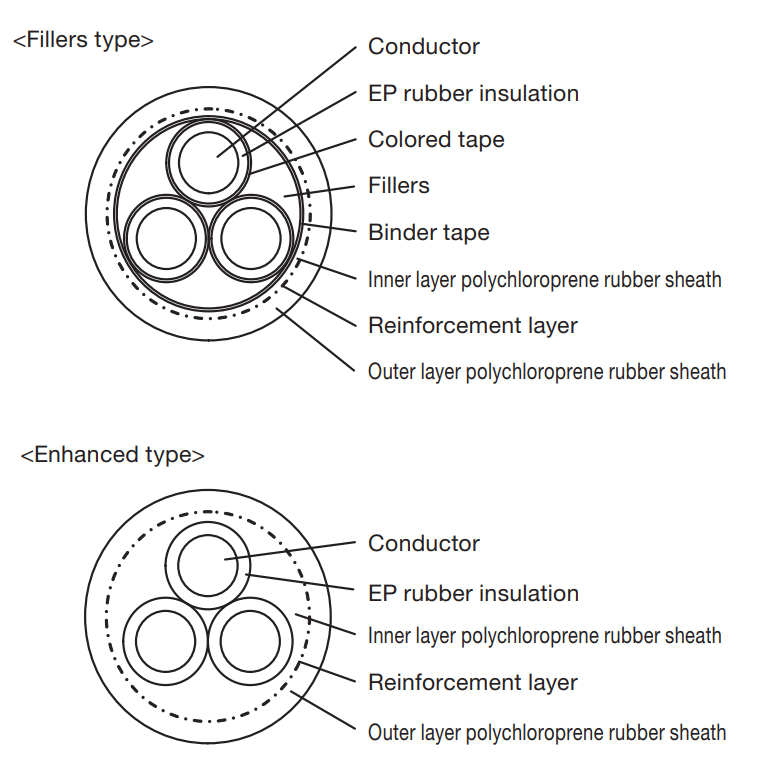

Frequently Asked Questions (FAQ)
General Information
What is the Type 3TC-RB (3PNCT) Reeling Rubber Cable?
It's a Class 3, 600V rubber-insulated cable designed for dynamic applications requiring frequent flexing, such as in curtain systems and cableveyor methods.What does "3PNCT" stand for?
"3PNCT" refers to a three-core Polyvinyl Chloride-insulated, Neoprene-sheathed Cabtyre cable, indicating its construction and insulation materials.Which standards does this cable comply with?
It complies with JIS C 3327, ensuring it meets Japanese Industrial Standards for rubber-insulated cables.What are the primary applications for this cable?
It's used in dynamic industrial settings like curtain systems, carrier drums, and cableveyor methods, where flexibility and durability are essential.What voltage rating does this cable have?
The cable is rated for 600V, suitable for low-voltage power applications.
Construction & Materials
What type of conductor is used?
Tin-coated annealed copper strand wire, offering excellent conductivity and corrosion resistance.What insulation material is utilized?
Ethylene Propylene Rubber (EP rubber), known for its flexibility and thermal stability.What is the sheath made of?
Polychloroprene rubber, providing resistance to oils, chemicals, and environmental factors.Is there a reinforcement layer?
Yes, a reinforced layer midway through the sheath enhances resistance to external damage and impact.How are the wire cores identified?
Color coding: 2-core (Black, White), 3-core (Black, White, Red), 4-core (Black, White, Red, Green), 5-core or higher uses a tracer method.
Performance & Durability
How does the cable perform under mechanical stress?
The reinforced sheath and flexible insulation allow it to withstand frequent bending and reeling without degradation.Is the cable resistant to environmental factors?
Yes, the sheath provides excellent resistance to oils, chemicals, UV radiation, and temperature variations.What is the operating temperature range?
Typically, -40°C to +90°C, depending on specific installation conditions.Does the cable have flame-retardant properties?
Yes, the materials used are inherently flame-retardant, enhancing safety in industrial environments.What is the expected service life?
With proper installation and maintenance, the cable offers a long service life, even in demanding applications.
Installation & Handling
What is the minimum bending radius?
Generally, six times the cable's outer diameter, but always refer to manufacturer guidelines for specific values.Can the cable be used in vertical installations?
Yes, it's suitable for both horizontal and vertical applications, including vertical reel winding methods.Is special equipment needed for installation?
Standard cable handling equipment is sufficient, but care should be taken to avoid twisting and excessive tension.Can the cable be used outdoors?
Yes, the sheath's resistance to UV and environmental factors makes it suitable for outdoor use.Are there specific installation precautions?
Avoid exceeding the bending radius, prevent twisting, and ensure proper support to maintain cable integrity.
Maintenance & Safety
How should the cable be maintained?
Regular inspections for wear, proper tension, and environmental damage are recommended to ensure longevity.What are signs of cable wear?
Cracks in the sheath, discoloration, stiffness, or exposed conductors indicate potential issues.Is the cable safe in high-temperature environments?
Yes, within its specified operating temperature range, it maintains performance and safety.Can the cable be repaired if damaged?
Minor sheath damages can sometimes be repaired, but significant damage may require cable replacement.Does the cable emit toxic fumes when burned?
The materials are designed to be flame-retardant and minimize toxic emissions, but burning any cable should be avoided.
Technical Specifications
What is the conductor resistance?
Resistance varies by size; for example, a 3.5mm² conductor typically has a resistance of 5.38 Ω/km at 20°C.What is the insulation resistance?
Minimum insulation resistance is generally 500 MΩ·km at 20°C, ensuring electrical safety.What is the test voltage?
The cable is tested at 3000V for one minute to ensure insulation integrity.What sizes are available?
Sizes range from 1.25mm² to 325mm², accommodating various current requirements.What is the approximate weight?
Weight depends on size; for instance, a 3.5mm² cable weighs approximately 90 kg/km.
Environmental & Compliance
Is the cable environmentally friendly?
While designed for durability, proper disposal and recycling practices should be followed to minimize environmental impact.Does it meet international standards?
Primarily designed to meet JIS C 3327, but it may also comply with other international standards; verify with the manufacturer.Is the cable recyclable?
Components like copper conductors can be recycled; consult local regulations for proper disposal methods.Does the cable contain hazardous substances?
It is manufactured to comply with safety standards, minimizing hazardous substances; always refer to the material safety data sheet (MSDS).Can the cable be used in cleanroom environments?
While not specifically designed for cleanrooms, its low outgassing materials may be suitable; consult with the manufacturer for confirmation.
Type 2TC-RH Reeling Rubber Cable: Engineered for Horizontal Reel Winding Excellence
Discover the Type 2TC-RH Reeling Rubber Cable—engineered for horizontal reel winding applications. Featuring tin-coated copper conductors, EP rubber insulation, and a polychloroprene sheath, this cable offers exceptional flexibility, durability, and compliance with JIS C 3327 standards. Ideal for dynamic industrial environments requiring reliable performance.
5/1/202511 min read
